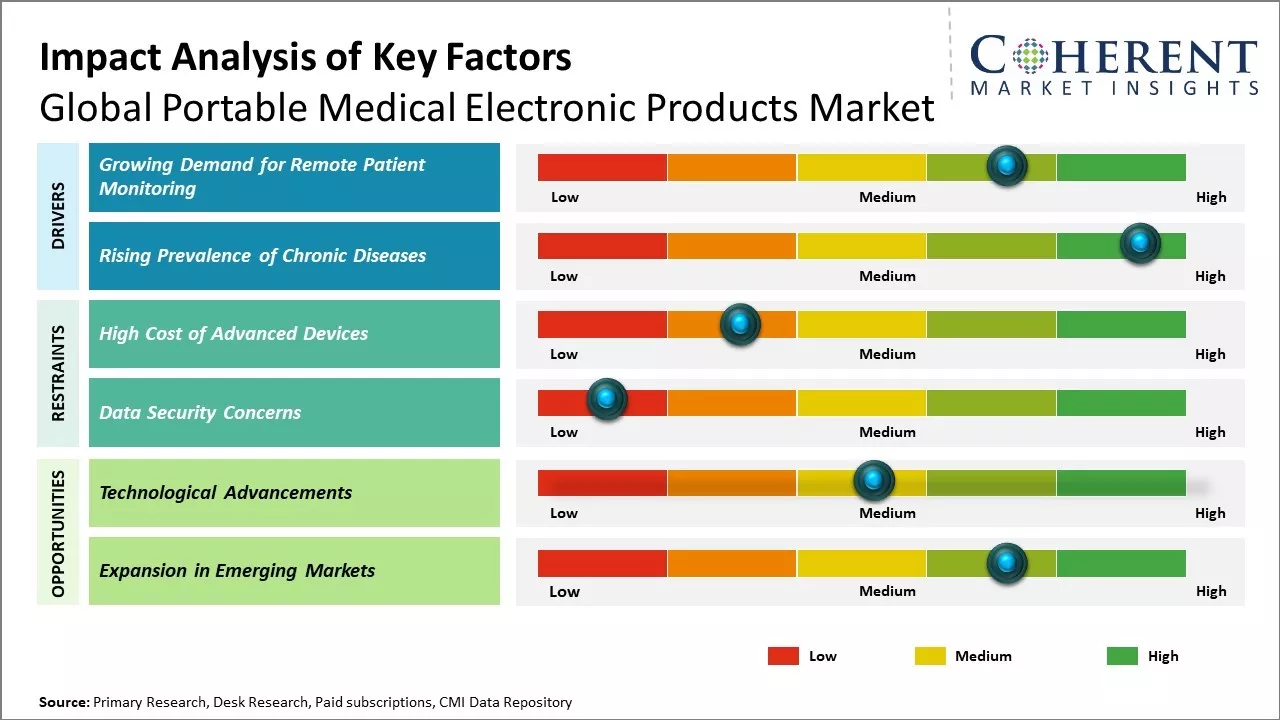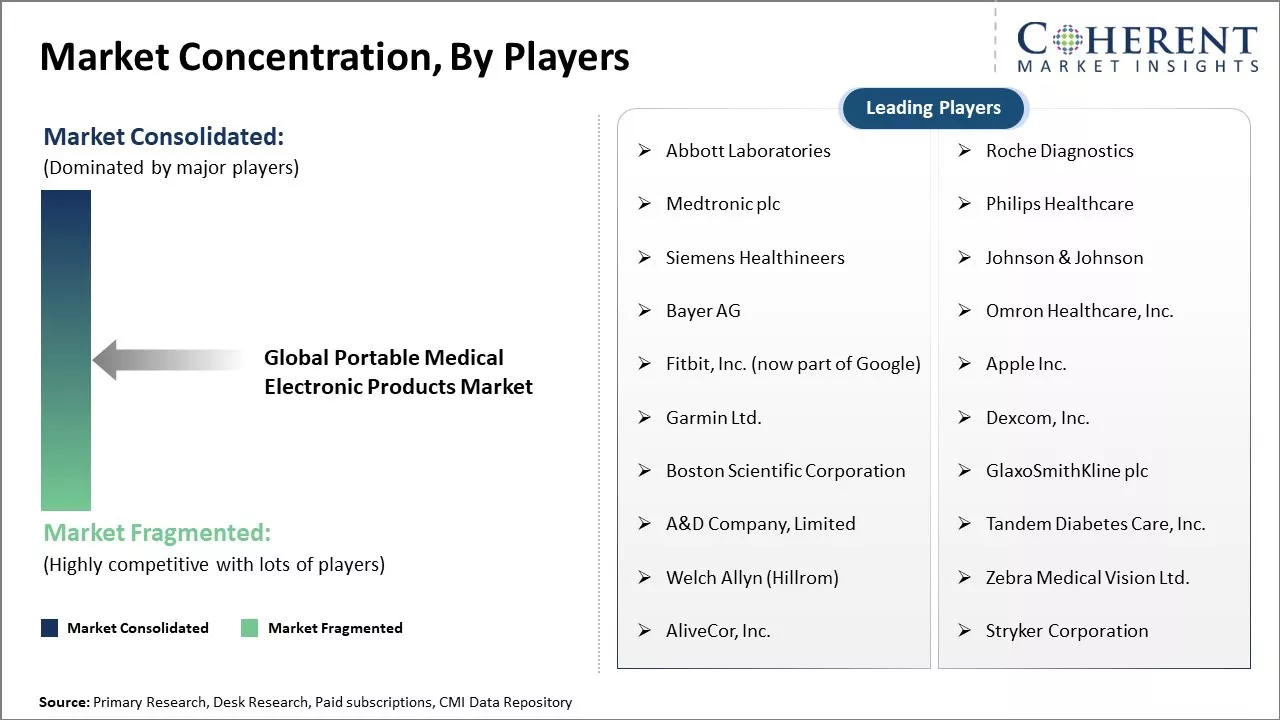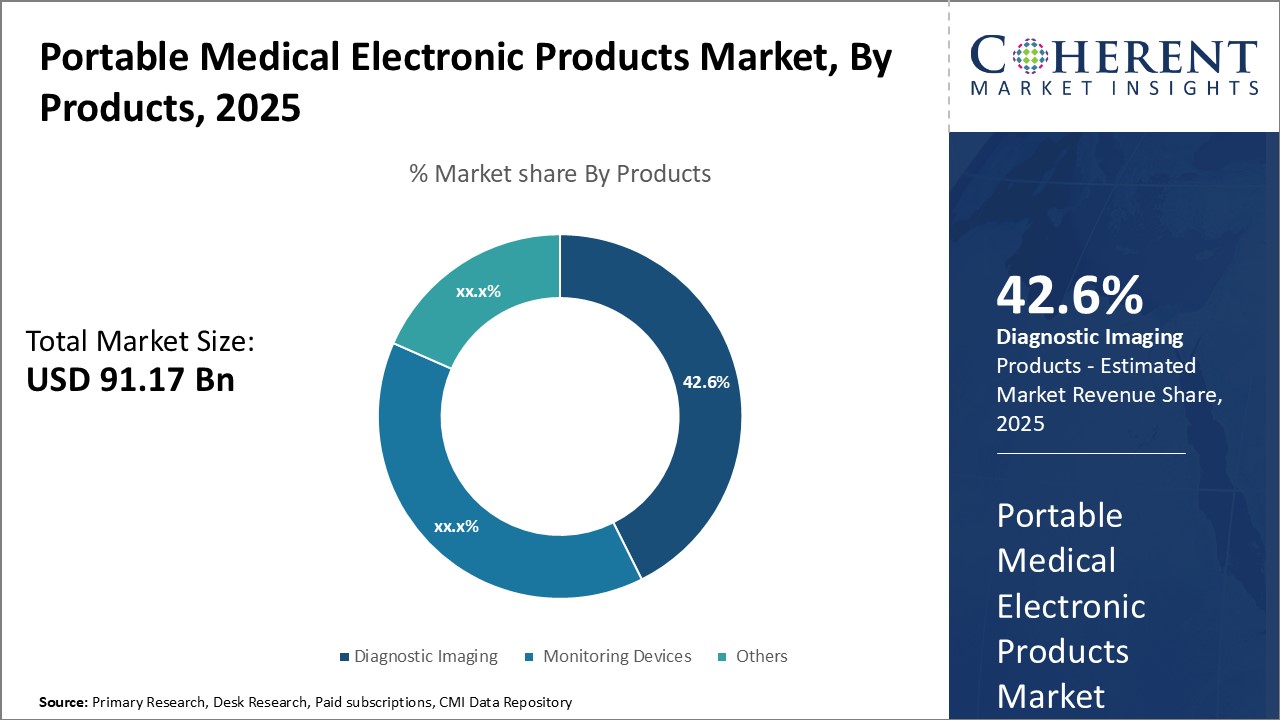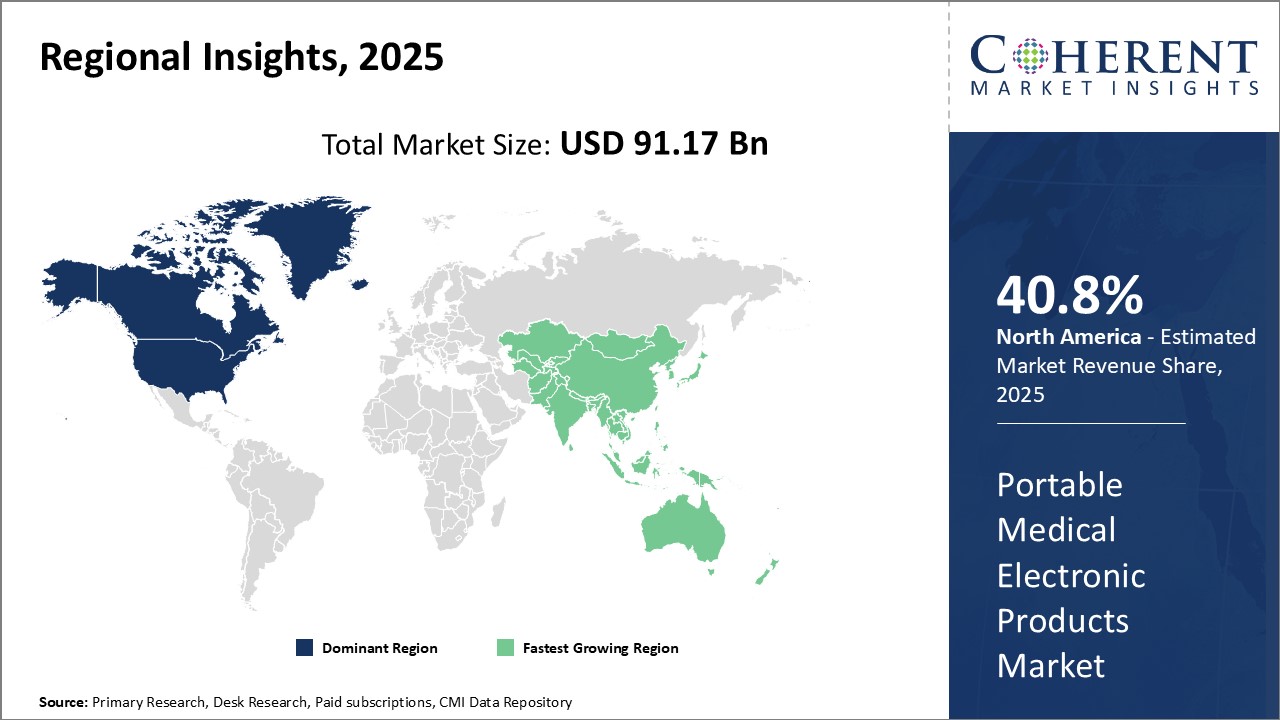Portable Medical Electronic Products Market Size and Trends
The global portable medical electronic products market is estimated to be valued at USD 91.17 Billion in 2025 and is expected to reach USD 174.41 Billion by 2032, exhibiting a compound annual growth rate (CAGR) of 9.7% from 2025 to 2032. Rising disposable incomes and increases health awareness among the global population are the major factors driving the demand for portable medical devices.

Discover market dynamics shaping the industry: Download Free Sample
The market is witnessing rising demand for personalized and wireless medical devices due to the increasing preference for home healthcare among patients. Technological advancements enabling miniaturization and improved portability of devices along with growing telemedicine and remote patient monitoring trends are expected to boost the demand for portable medical electronic products over the forecast period.
Growing Demand for Remote Patient Monitoring
The healthcare industry has undergone rapid transformation in recent years with advanced medical devices and technologies revolutionizing patient care. One such area that has witnessed tremendous growth is remote patient monitoring which utilizes connected medical devices, apps, and platforms to monitor patients outside of conventional clinical settings. The traditional model of patients visiting healthcare facilities for routine checkups and treatments is steadily being replaced with remote monitoring solutions that allow the continuous tracking of vital signs and symptoms in the comfort of one's own home.
This shift is being driven by a number of factors such as the increasing preference among physicians and patients for less invasive treatment procedures and shorter hospital stays. Remote monitoring provides an improved follow up mechanism post treatment by facilitating close checks on recovery progress from the home without re-admission. It also enables earlier detection of deteriorations in health conditions through constant data transmission to provider portals. For elderly patients or those with limited mobility, remote care cuts down on unnecessary travel while still maintaining follow ups. The cost benefits from reduced hospitalization are proving attractive for both individuals as well as insurance providers.
The ongoing COVID-19 pandemic has further accelerated the widespread adoption of remote care practices. As social distancing became important, remote patient monitoring helped bridge the gap and continue essential care. It allowed higher risk individuals and those recovering from COVID-19 infections to be closely watched without physical visits. Telehealth consultations integrated with the home use of connected devices formed a viable alternative to in-person consultations. Going forward, remote monitoring is expected to remain an integral part of healthcare even post pandemic by facilitating affordable chronic care management. For instance, in February 2022, Healthnet Global, a subsidiary of Apollo Hospitals, launched Automaid, an advanced in-patient room automation system designed for remote patient monitoring and triaging.
Market Concentration and Competitive Landscape

Get actionable strategies to beat competition: Download Free Sample
Rising Prevalence of Chronic Diseases
Non-communicable or chronic diseases have emerged as a major public health challenge globally in recent decades. Long term conditions like diabetes, cardiovascular disease, respiratory diseases, and cancer now account for the bulk of mortality worldwide. According to the WHO, chronic illness will contribute significantly to the worldwide disease burden with billions of people requiring long term treatment and management. The aging population, sedentary lifestyles, and risk factors like obesity have led to a steady rise in chronic disease incidence rates in developed as well as newly industrializing nations.
This uptick presents both a financial as well as patient care burden for healthcare systems with demand for resources increasing in parallel. Chronic conditions require the consistent monitoring of symptoms and adherence to medication schedules or treatment plans on an ongoing basis. Traditional clinical settings alone cannot manage such high patient volumes requiring lifelong care.
Remote monitoring technology addresses a critical need to enhance disease management at reduced costs. It allows physicians to detect irregularities that could indicate complications and intervene in a timely manner. This helps avoid expensive emergency admissions and bridge gaps in rural access to care. Moreover, continuous digital engagement and education of patients through such tools improves adherence to treatment over the long run. Chronic conditions are projected to continue rising which will further cement the role of portable connected healthcare solutions. For instance, in May 2023, WHO’s latest World Health Statistics report warns of the growing threat of non-communicable diseases (NCDs), which could account for 86% of deaths by 2050 if current trends continue. The report also highlights the impact of COVID-19, which has stalled progress towards global health goals and reversed gains in areas like malaria and tuberculosis. Despite these challenges, global life expectancy has increased from 67 years in 2000 to 73 years in 2019, though the pandemic has deepened healthcare inequalities. The WHO calls for greater investment in health systems to achieve Sustainable Development Goals (SDGs).
Key Takeaways from Analyst:
The global portable medical electronic products market is poised to witness significant growth in the coming years driven by growing elderly population globally which is increasing the demand for remote patient monitoring devices. Rising incidence of chronic diseases like diabetes, cardiac issues, and respiratory diseases is also propelling the demand for portable medical devices for patient monitoring and treatment. Technological advancements in wearable medical devices, implantable medical devices, and remote patient monitoring systems provide continuous real-time health insights which help patients to manage their diseases efficiently.
However, data security and privacy concerns related to connected medical devices can negatively impact the adoption of portable medical electronic products. High cost of advanced wearable devices also restrains the market especially in price sensitive developing economies. Lack of reimbursement policies and standardization challenges further hinders the market growth.
The Asia Pacific region is expected to grow at the fastest pace during the forecast period owing to improving healthcare infrastructure, rise in medical tourism, and increasing healthcare spending in emerging economies like India and China. North America dominates the current market followed by Europe due to the presence of prominent players, strong economy, and increasing investment in R&D. Continued innovation in design, features and connectivity of portable medical devices offers lucrative opportunities for market players to expand. Integration of artificial intelligence capabilities & augmented reality features will further drive the future growth of this market.
Market Challenge - High Cost of Advanced Devices
One of the major challenge faced in the global portable medical electronic products market is the high cost of advanced devices. As technological advancements are enabling manufacturers to incorporate more features into portable medical devices, the R&D and manufacturing costs have increased significantly. This is putting pressure on pricing and making high-end portable medical devices unaffordable for common consumers. Additionally, the regulatory compliance and quality standards associated with medical devices have also pushed the costs higher. The manufacturers have to balance enhancing functionality with maintaining reasonable pricing to gain larger consumer base. However, bringing down prices substantially without compromising on quality and safety is a major challenge. This high cost of advanced portable devices is restricting the faster adoption of innovative products in the market.
Market Opportunity- Technological Advancements
Continuous technological advancements provide huge opportunities for growth in the global portable medical electronic products market. Miniaturization of components and new form factors are enabling manufacturers to develop portable devices with more compact sizes and advanced features. Additionally, developments in areas like AI, IoT, wireless technologies, and advanced sensors are fueling innovation. This is leading to the launch of portable devices with new applications and functionalities. For example, integration of AI is helping to develop portable diagnostic tools with advanced predictive capabilities. Similarly, wireless connectivity and IoT integration are supporting remote patient monitoring applications using portable devices. Moreover, continual R&D in areas like energy storage, advanced displays, and material science is improving user experience with portable medical devices. The technological innovations are expanding application areas and driving new product developments in the market.

Discover high revenue pocket segments and roadmap to it: Download Free Sample
Insights by Products - Increasing Prevalence of Chronic Diseases Drives Growth in Diagnostic Imaging
In terms of products, the diagnostic imaging segment is estimated to dominate with the highest share of the market with 42.6% in 2025 owing to the increasing prevalence of chronic diseases globally. Diagnostic imaging allows for early detection of diseases as well as monitoring of existing conditions, helping improve patient outcomes. The aging global population particularly drives demand as elderly individuals are more susceptible to developing conditions like cancer, heart disease and stroke. Portability is a major advantage of these devices as it enables diagnostic tests to be performed at the point of care, avoiding delays in treatment. Technologies like ultrasound, X-ray and MRI provide high-quality images without the need for large and expensive infrastructure. With growing health awareness and improved access to healthcare in developing countries, demand for portable diagnostic equipment is rising rapidly.
Insights by Application - Better Treatment Options Boost Cardiology Applications
In terms of application, the cardiology segment is estimated to contribute the highest share of 41.7% in 2025 significantly owing to technological advancements improving the treatment of heart conditions. Portable monitoring devices play a vital role in diagnosing cardiac issues and managing patients with conditions like arrhythmias, hypertension and congestive heart failure. Wearables like Holter monitors and ECG machines enhance convenience and allow for remote patient monitoring. This is beneficial particularly for older patients needing long-term surveillance of heart health. Furthermore, rising rates of obesity and lifestyle diseases increase the risk of cardiovascular problems. Easy-to-use portable equipment empower physicians to provide effective cardiac care and interventions earlier.
Insights by End User - Increased Access and Flexibility Fuel Hospital Adoption
In terms of end user, the hospitals segment is expected to account for the largest share with 41.6% in 2025 due to improved access and service flexibility offered by portable devices. Congested hospital infrastructure and staff shortages are perennial issues globally. Portable medical products help optimize workflows and resource utilization. For example, point-of-care diagnostics save time by delivering rapid test results during patient visits. Mobile monitoring equipment facilitate early discharges as patients can continue treatment from home. Furthermore, portable imaging technologies enable performing scans on non-ambulatory patients directly in wards. This boosts hospital efficiency while enhancing patient comfort. With healthcare costs continuously rising, portable products assist hospitals in effective capacity management.
Regional Insights

Need a Different Region or Segment? Download Free Sample
North America has established itself as the dominant regional market for portable medical electronic products. The region is expected to hold a market share of 40.8% in 2025. Home to major industry players like Medtronic, GE Healthcare, and Philips Healthcare, North America has a strong presence across the value chain from manufacturing to distribution. Regulatory standards in the U.S. and Canada are robust which ensures the reliable quality of devices. With rising healthcare spending per capita, the demand for personal healthcare devices is high in the region as consumers increasingly take preventive measures and self-monitor chronic conditions. Given the consolidation of manufacturers and distributors, pricing for medical devices across therapy areas tend to be stable in North America.
The Asia Pacific region, especially China and India, represents the fastest growing market for portable medical electronics globally. Having a combined population of over 2.6 billion, the rising burden of non-communicable diseases and expanding middle class are driving demand. Local manufacturing is encouraged through favorable policies. Multiple global players have established manufacturing facilities in these emerging nations to cater to the regional needs as well as export opportunities globally. Trade agreements with North America and Europe have opened up new export markets. Local companies in Asia Pacific are also emerging as innovators in affordable medical device technologies that address the needs of value conscious consumers. However, quality certification and intellectual property protection remain areas that need further strengthening for the region to maximize its potential.
Market Report Scope
Portable Medical Electronic Products Market Report Coverage
| Report Coverage | Details | ||
|---|---|---|---|
| Base Year: | 2024 | Market Size in 2025: | USD 91.17 Bn |
| Historical Data for: | 2020 To 2024 | Forecast Period: | 2025 To 2032 |
| Forecast Period 2025 to 2032 CAGR: | 9.7% | 2032 Value Projection: | USD 174.41 Bn |
| Geographies covered: |
|
||
| Segments covered: |
|
||
| Companies covered: |
Abbott Laboratories, Roche Diagnostics, Medtronic plc, Philips Healthcare, Siemens Healthineers, Johnson & Johnson, Bayer AG, Omron Healthcare, Inc., Fitbit, Inc. (now part of Google), Apple Inc., Garmin Ltd., Dexcom, Inc., Boston Scientific Corporation, GlaxoSmithKline plc, A&D Company, Limited, Tandem Diabetes Care, Inc., Welch Allyn (Hillrom), Zebra Medical Vision Ltd., AliveCor, Inc., and Stryker Corporation |
||
| Growth Drivers: |
|
||
| Restraints & Challenges: |
|
||
Uncover macros and micros vetted on 75+ parameters: Get instant access to report
Market Segmentation
- By Products Insights (Revenue, USD Bn, 2020 - 2032)
-
- Diagnostic Imaging
- Monitoring Devices
- Others
- By Application Insights (Revenue, USD Bn, 2020 - 2032)
-
- Gynecology
- Cardiology
- Gastrointestinal
- Urology
- Neurology
- Respiratory
- Orthopedics
- Others
- By End User Insights (Revenue, USD Bn, 2020 - 2032)
-
- Hospitals
- Physician Offices
- Homecare Settings
- Others
- By Regional Insights (Revenue, USD Bn 2020 - 2032)
- North America
- U.S.
- Canada
- Latin America
- Brazil
- Argentina
- Mexico
- Rest of Latin America
- Europe
- Germany
- U.K.
- Spain
- France
- Italy
- Russia
- Rest of Europe
- Asia Pacific
- China
- India
- Japan
- Australia
- South Korea
- ASEAN
- Rest of Asia Pacific
- Middle East
- GCC Countries
- Israel
- Rest of Middle East
- Africa
- South Africa
- North Africa
- Central Africa
- North America
- Key Players Insights
-
- Abbott Laboratories
- Roche Diagnostics
- Medtronic plc
- Philips Healthcare
- Siemens Healthineers
- Johnson & Johnson
- Bayer AG
- Omron Healthcare, Inc.
- Fitbit, Inc. (now part of Google)
- Apple Inc.
- Garmin Ltd.
- Dexcom, Inc.
- Boston Scientific Corporation
- GlaxoSmithKline plc
- A&D Company, Limited
- Tandem Diabetes Care, Inc.
- Welch Allyn (Hillrom)
- Zebra Medical Vision Ltd.
- AliveCor, Inc.
- Stryker Corporation
Share
Share
About Author
Komal Dighe is a Management Consultant with over 8 years of experience in market research and consulting. She excels in managing and delivering high-quality insights and solutions in Health-tech Consulting reports. Her expertise encompasses conducting both primary and secondary research, effectively addressing client requirements, and excelling in market estimation and forecast. Her comprehensive approach ensures that clients receive thorough and accurate analyses, enabling them to make informed decisions and capitalize on market opportunities.
Missing comfort of reading report in your local language? Find your preferred language :
Transform your Strategy with Exclusive Trending Reports :
Frequently Asked Questions
EXISTING CLIENTELE
Joining thousands of companies around the world committed to making the Excellent Business Solutions.
View All Our Clients
